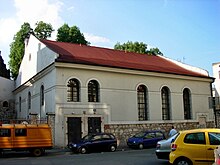Kupa Synagogue
| Kupa Synagogue | |
|---|---|
Synagoga Kupa | |
 Kupa Synagogue, Kraków | |
| Religion | |
| Affiliation | Judaism |
| District | Kazimierz |
| Status | Active synagogue |
| Location | |
| Location | Kraków, Poland |
| Geographic coordinates | 50°03′41″N 19°56′14″E / 50.06139°N 19.93722°E |
| Architecture | |
| Style | Baroque |
| Groundbreaking | 1643 |


Kupa Synagogue (Polish: Synagoga Kupa) is a 17th-century synagogue in Kraków, Poland. It is located in the former Jewish quarter of Kazimierz developed from a neighborhood earmarked in 1495 by King John I Albert (Polish: Jan I Olbracht) for the Jewish community, which has been transferred from the budding Old Town. Kupa Synagogue serves Kraków's Jewish community as one of the venues for religious ceremonies and cultural festivals, notably the annual Jewish Culture Festival in Kraków.[1]
History[edit]
The Synagogue was founded in 1643 by the Kazimierz Jewish district's kehilla (a municipal form of self-government), as a foundation of the local qahal. A contribution of 200 zlotys by the Jewish goldsmiths' guild helped to bring the construction to its successful completion. The Synagogue was built in a baroque style with a square prayer hall inside. The building underwent many renovations throughout the centuries. In 1830-1834 the two-storey annex was added with entrance hall and washrooms. In 1861 the western wing was built. At the end of the 19th century, the synagogue was joined with the adjacent building. The synagogue was burned down by a Polish mob during the Kraków pogrom, shortly after the end of World War II, and has been meticulously restored since. Its northern wall connects with the remnants of the medieval city-wall of Kazimerz while its southern flank faces Warchauera Street. The colorful interior of the Kupa Synagogue serves as an exhibition hall and the venue for musical events.
The Synagogue is richly decorated with paintings from the 1920s featured on walls, the ceiling and in the women's section. The depictions include the holy places of Hebron, Tiberias, and Jerusalem. There are also Biblical scenes and illustrations to verses in Psalms, such as the painting showing people standing by the rivers of Babylon (Psalms 137:1–3), or musical instruments (Psalms 150:3–6). Another painting depicts Noah's ark including the figure of Noah – quite unusual since the use of human images was very rare in Jewish art.[2] The signs of the Zodiac are painted over the women's gallery. The artist, although unidentified, was clearly professional. There are also remnants of earlier paintings from the 17th to 18th centuries. The older drawings are ornamental, with leaves and fruit surrounding texts. A carved wood and stucco Torah Ark, from the early 17th century, adorns the interior.
See also[edit]
Notes[edit]
- ^ Jewish Krakow, A Visual and Virtual Tour, The Kupa Synagogue: ul. Miodowa 27 from the Internet Archive
- ^ Hebrew University of Jerusalem: "Exploring the Synagogues of Poland: Wall Painting and Decoration"
References[edit]
- "Old Kleparz" at Poland: What Where When
- Marek Strzala, Synagogues of the Kazimierz district
- Aneta Kalemba, Poland: Online presentation
- Steven Spielberg's Righteous Persons' Foundation, "Exploring the Synagogues of Poland" from the Internet Archive
- The Jewish Community of Krakow
External links[edit]
 Media related to Kupa Synagogue of Kazimierz, Kraków at Wikimedia Commons
Media related to Kupa Synagogue of Kazimierz, Kraków at Wikimedia Commons- Virtual tour at YouTube.com
